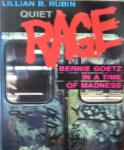On December 22, 1984, a thin, blond, seemingly orginary young man shot four teeneagers on a New York subway train. In a city where violent crimes are commonplace, where everyone talks about the hazards of riding the subway, such an event would not seem extraordinary. Yet this was different. The gunman was white, the youths black. And his shots sent a tremor across the land. Finally, someone did more than complain; someone stood up to the hoodlums and taught them a lesson. But is this what happened?
Although the shootings and the subsequent legal maneuverings in the Goetz case have been minutely covered by the press and on television, no one has made a serious attempt either to understand Bernie Goetz or to explain why this event has become one of the most controversial and emotional issues of recent times.
In Quiet Rage Lillian Rubin brings together all her impressive skills as psychologist and writer. She examines Goetz’s past childhood experiences and convincingly traces the forces and events that led almost inexorably to the subway shootings.
But this book is more than the story of one quiet man moved to violence. It also illuminates the social responses to Goetz’s act and clarifies why he became such a powerful symbol. Written like a novel, this gripping narrative is a moving and human document of families, of hate and love, of poverty and race, of the quiet rage so many Americans — black and white, have and have-nots — have lived with for so long.
Quiet Rage offers a choice and a challenge. The story Lillian Rubin tells asks us to rise above our prejudices and our rage, in the hope of stemming the urban wars that are now upon us.
